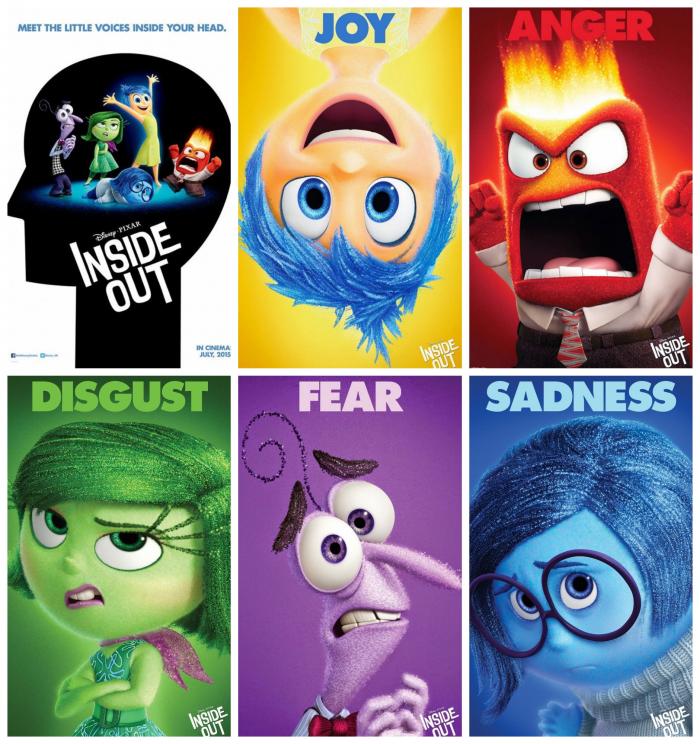INSIDE OUT is Pixar's plucky ode to HERMAN'S HEAD
FTC Statement: Reviewers are frequently provided by the publisher/production company with a copy of the material being reviewed.The opinions published are solely those of the respective reviewers and may not reflect the opinions of CriticalBlast.com or its management.
As an Amazon Associate, we earn from qualifying purchases. (This is a legal requirement, as apparently some sites advertise for Amazon for free. Yes, that's sarcasm.)

Remember HERMAN'S HEAD? It was a rather short-lived cult hit in the early days of the Fox Network. The show was about a fellow named Herman who had a Greek chorus of sorts who represented emotions arguing over the daily matters of Herman’s life. While the show is probably best remembered for being an early vehicle for Hank Azaria and Yeardley Smith who would go on to become Fox mainstays on THE SIMPSONS, HERMAN'S HEAD was probably a show before its time. It went for the laughs, with guest appearances by Bobcat Goldthwait and Leslie Nielsen, but it never garnered high ratings and was cancelled after three seasons.
Pixar’s latest animated feature, INSIDE OUT, is HERMAN'S HEAD revisited. The story follows the tumultuous cross-country move of 11-year old Riley Anderson (voiced by Kaitlyn Dias), a young girl who has an idyllic life going in Minnesota. When her father takes a job in San Francisco and uproots the family, she leaves her hockey team, classmates, and comfort of familiar surroundings behind. The move does not go smooth, and the added stresses of a new school, a new hockey team, trying to make new friends, wondering when the moving van from Hell is ever going to arrive with their stuff all stress her fragile pre-pubescent psyche to the limit. Here’s where the HERMAN'S HEAD reference comes in: the majority of the film takes place in Riley’s head. Joy, wonderfully bubbly as voiced by Amy Poehler, is the de facto ringleader of the emotions that control Riley’s “central headquarters,” churning out as many positive memories as they can. Joy’s coworkers are Anger (there could be no better choice than Lewis Black), Fear (Bill Hader), Disgust (Mindy Kaling) and Sadness (Phyllis Smith). These five generally get along, taking turns at the controls when appropriate, though Joy tries to keep Sadness busy reading Memory Core manuals instead of getting Riley all worked up. Joy and Sadness inadvertently get sucked out of headquarters while wrestling over a core emotion that Sadness had tainted, and deposited in the vast warehouse of all of Riley’s memories. The rest of the film consists of Joy and Sadness trying to find their way back, through one perilous obstacle after another, at times assisted by Riley’s almost-forgotten imaginary friend Bing Bong (the unmistakable Richard Kind), while Fear, Disgust and Anger do what they do best, which unfortunately gets Riley worked up into an explosive ball of negativity. Along the way, Joy figures out that Sadness is necessary to temper Riley’s experiences, to help her learn from her mistakes and process difficult situations.
The time it took you to read that last paragraph may be about as long as it will take for younger viewers to lose interest. The first 20-30 minutes are pretty funny, with Hader and Lewis earning laughs with nearly every line. Poehler’s plucky heroine is instantly likable, and Kaling’s Disgust is surprisingly charming in a weird way. Phyllis Smith quietly becomes the heart of the movie. Despite the strong performances and top notch animation (and once again underwhelming 3D) that one would expect from Pixar, director Pete Docter (MONSTER’S INC, UP) lost most of the 6 and under audience at my screening. The kids to my left were fidgety and bored; the bright colors and flashy artwork were not holding their interest. Kids a little older than that seemed to relate better, but it seemed to me that the 20 and up crowd were deeply invested as the three college girls to my right laughed out loud through the first half and muffled sobs in the more psychologically introspective second half. The DESPICABLE ME audience isn't going to understand the references to the Id and Super Ego. Heck, I barely recall studying Freud and Jung in college anymore.
I’ll admit that I am not a particularly good judge of age appropriateness—I find the target age for so-called “Young Adult” novels completely unfathomable. There’s certainly nothing particularly inappropriate in the film, but parents with children under 10, perhaps, might be surprised to find themselves more engaged in the film than their young children are. Most of the adults at my screening, myself included, liked it a lot. It's a very well-acted and well-executed film. By all means brings the kids, but don’t be shocked if your younger viewers are more interested in concession snacks than the on screen action.


